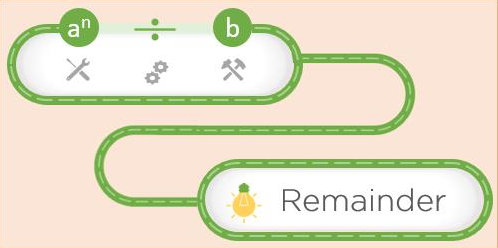This is the 2nd article on the topic of remainders and its applications. If you have not read the previous article, we recommend you read that first before going through this article.
To read the article: Common Mistakes One Must Avoid in Remainders
The primary objective of this article is to demonstrate 2 specific cases, where we use the concepts of remainders in different ways to determine the answer.
In the explanation, we have considered the cases with the help of two different questions and discussed their solution using different methods to demonstrate the important takeaways.

Case 1:
The Context
While finding the remainder when a generic expression is divided by a certain number, many of us resort to the conventional way of applying properties of remainders of certain numbers to figure out the final answer. Although this is certainly the correct method to solve the question, sometimes we can get the answer using a simpler and time-saving approach.
Let us take the first example and understand the same.
Question
P is a two-digit number with exactly two factors. What is the remainder when (P2 – 1) is divided by 6?
- 0
- 1
- 2
- 4
- 5
Understanding the Question
Let us read the question stem first and draw all the pertinent inferences from the given information.
In this question, we are given that P is a two-digit number, with exactly two factors.
- Now, if P has exactly two factors, can we specify anything about P?
- Yes, we can. We know that a number with exactly two factors is nothing but a prime number.
- Hence, we can say that P is a two-digit prime number.
- Can we make any other inferences?
- Yes, we can also say that P is an odd number, as any prime number greater than 2 is always an odd number.
Now, we need to find out the remainder, when P2 – 1 is divided by 6.
We can solve this question in more than one way – let’s discuss them one-by-one.
Method 1
In this approach, we will use the general property of any prime number greater than 3.
We know that if we have a prime number greater than 3, we can express that number in 6k + 1 or 6k – 1 form, where k is a positive integer.
As P is a two-digit prime number, we can also express P in the form 6k + 1 or 6k – 1.
Case-1: P = 6k +1,
- P2 = (6k + 1)2 = 36k2 + 12k + 1
Or, P2 – 1 = 36k2 + 12k
Or, P2 – 1 = 6 (6k2 + 2k)
We can see that P2 – 1 is a multiple of 6. Hence, if we divide P2 – 1 by 6, the remainder will be 0.
Case-2: P = 6k – 1
- P2 = (6k – 1)2 = 36k2 – 12k + 1
Or, P2 – 1 = 36k2 – 12k
Or, P2 – 1 = 6 (6k2 – 2k)
We can see that P2 – 1 is a multiple of 6. Hence, if we divide P2 – 1 by 6, the remainder will be 0.
Therefore, we can see that whether P is 6k + 1 or 6k – 1, the remainder when P2 – 1 is divided by 6 is always 0.
Hence, the correct answer is option A.
Now, let’s solve the same question using a different approach.
Method 2: (Intuitive way to solve using GMAT remainders concept)
This method is much simpler and more intuitive. Here we don’t need to know any specific property of prime numbers to solve the question.
If we look at the option choices, we are given five definite numbers and no option says the answer cannot be determined.
- Hence, we can definitely say that for any value of P, our answer will be always the same, right?
- So, let’s try to find the remainder, using some values of P.
We know that P is a two-digit prime number. Let’s assume P = 11.
- So, P2 – 1 = 112 – 1 = 121 – 1 = 120
Now, 120 is divisible by 6, hence, if P2 – 1 is divided by 6, the remainder is 0.
Let’s try the same with a different value of P.
Assume that P = 19.
- So, P2 – 1 = 192 – 1 = 361 – 1 = 360
Again, 360 is divisible by 6, hence, if P2 – 1 is divided by 6, the remainder is 0.
As we can see, for any value of P, the remainder when P2 – 1 is divided by 6 is always 0. Hence, the correct answer choice is option A.
Case 2:
The context
There are some specific cases of remainders, where we can apply our conceptual learning from other topics and find the solution in a faster way. Let’s see that in the following example.
Question
What is the remainder when 22020 is divided by 5?
- 0
- 1
- 2
- 3
- 4
Understanding the Question
This remainder question belongs to one of the most conventional question types which are tested very frequently in the GMAT.
In this question, we are asked to find out the remainder, when the number 22020 is divided by 5. We will solve it in two ways – let’s start discussing the first method.
Method 1
In our first method, we will use the conventional process of finding out the remainder.
As we are dividing 22020 by 5, we will first try to find out the value of one such power of 2, which can be expressed in the form 5k + 1 or 5k – 1.
- From observation, we can say that 24 is 16, which is 5 x 3 + 1.
- Hence, we can say that if we divide 24 by 5, we get a remainder 1.
Now, we can express the given numerator in the form of 24.
- 22020 can be written as (24)505.
- So, the remainder when 22020 is divided by 5 will be same as the remainder when (24)505 is divided by 5.
- Or, in other words, the remainder will be the same when (1)505 is divided by 5.
- As (1)505 is equal to 1, we can say the final remainder is 1.
Hence, the correct answer choice is option B.
Important Observation
Some of us may have questioned that is it really necessary to express 22020 in terms of 24 only? What happens if we express 22020 in terms of any other powers of 2?
- Well, we can express the numerator in terms of other powers of 2 also. In such cases, the calculation may differ and becomes lengthier, but the end result will always be the same. Let’ see how we can get that.
Assume that we have expressed 22020 in terms of 23. Hence, we can write 22020 as (23)673 x 2.
Now, we know, when 23 is divided by 5, the remainder is 3.
- Hence, we can rewrite the numerator as (3673) x 2.
We also know that 32, when divided by 5, gives a remainder 1.
- So, we can write (3673) x 2 as (32)336 x 3 x 2 or (1)336 x 3 x 2, which is equal to 6.
- Now, if we divide 6 by 5, we get a remainder 1.
Hence, the correct answer choice is option B.
So, we can see that we can get the correct answer even if we express the numerator in other forms, apart from the conventional form of (denominator x k ± 1) form. However, the number of steps and the calculation involved may increase in such cases.
Method 2 (Using GMAT Remainders concept of cyclicity)
Now, this method is specific to the values given in the question and may not be generalized for every remainder problem.
In this question, we are asked to find the remainder, when 22020 is divided by 5.
First, let us see what remainders we get when we divide different powers of 2 by 5.
- Remainder (21/5) = Remainder (2/5) = 2
- Remainder (22/5) = Remainder (4/5) = 4
- Remainder (23/5) = Remainder (8/5) = 3
- Remainder (24/5) = Remainder (16/5) = 1
- Remainder (25/5) = Remainder (32/5) = 2
- Remainder (26/5) = Remainder (64/5) = 4
- Remainder (27/5) = Remainder (128/5) = 3
- Remainder (28/5) = Remainder (256/5) = 1
- Remainder (29/5) = Remainder (512/5) = 2
- Remainder (210/5) = Remainder (1024/5) = 4 and so on…
Now, we can observe two important things from here.
Observation 1
The remainder can be calculated just by dividing the units digit of the number by 5. [For example, Remainder (28/5) = Remainder (256/5) = Remainder (6/5) = 1]
- This is always true when we divide any number either by 5 or by 10. While calculating the remainder, we can only find the units digit of the numerator and divide the units digit by 5 or 10, to get the answer.
- For example, 22020 has a units digit 6. If 6 is divided by 5, the remainder is 1. Hence, the remainder when 22020 is divided by 5 is 1.
Observation 2
The value of the remainder follows a particular cycle and gets repeated after every 4th power. [For example, the remainder is same for 21, 25, 29 and so on…]
- As the remainder gets repeated after every 4th power, we can express the numerator in a cycle of 4.
- 22020 can be written as (24)505. Now, we know that when 24 is divided by 5, the remainder is 1. Hence, we can also say that when (24)505 is divided by 5, the remainder is also 1.
So, we have seen that we can find the answer from different possible methods by using our concept of remainders. Let’s now consolidate our learning in the form of final takeaways.
Final takeaways from the article
- If we have a general expression given, then the expression is true for any valid number. For example, any prime number greater than 3 can be expressed as 6k ± 1, where k is a positive integer.
- Sometimes we can get our answer easily by substituting proper values in the general expression.
- To find the remainder when we divide a number by 5 or 10, we need to check for the unit digit of the number only.
- For the divisor 5, we need to divide the unit digit by 5 to get the remainder.
- For the divisor 10, the unit digit of the number is the remainder.
- If we try to find the remainder when the number of the form an is divided by b, we generally express the number in the numerator in the form (denominator x k ± 1). However, we can still get the correct answer if we express the numerator in any other form, apart from ‘± 1’ form – in such case, the calculation may become a bit lengthy.














